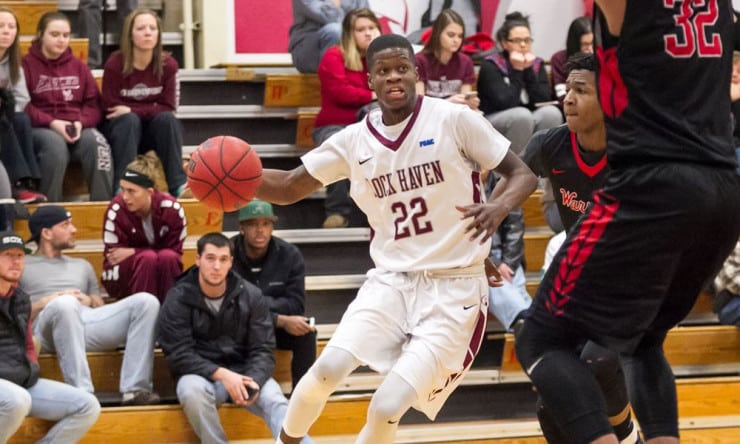NBA
NBA Daily: Division II Prospect Amir Hinton Could Be The Real Deal

While NBA greats like Earl Monroe, Ben Wallace and Charles Oakley hail from Division II college programs, they all played in different eras when being noticed by NBA scouts was a less streamlined process. That is not to say that making the NBA has ever been easy for non-Division I prospects. However, presently, NBA prospects are identified years before they are even eligible to play college basketball and finding one’s way into that discussion after enrolling in high school is nearly impossible.
And yet, here we are, in 2019 with an unprecedented number of domestic and international basketball scouts and when AAU stars begin making a name for themselves when they are as young as 13 years old. And yet players like Amir Hinton still slip through the cracks.
Hinton is a 22-year-old Shaw University junior who recently announced his intention to enter the 2019 NBA Draft. He blossomed a bit late in high school, coming into his own as a senior, but his ascension did not stop there.
Hinton led the NCAA Division II in scoring in 2018-19 with 29.4 points per game and was named CIAA Player of the Year. There are rumors that Hinton could be a late-first round talent. And considering he just made national news in declaring for the draft, basketball junkies should probably get familiar with the kid from Philadelphia.
Hinton is a 6’5 scoring guard with above-average court vision. He has a knack for creating space and getting to the hoop at will. He needs to improve on shooting from distance – Hinton shot 28% from on three-pointers this season – and he must remain cognizant of how much lift he gets on his jump shot, or lack thereof. But he also possesses a relatively quick release on his jumper and a range of moves, including a nasty step back, that led to a school record 52 points in one game this season. Hinton will need to put on muscle, as do most incoming rookies. And he must be cognizant of the increased speed of the game from the very first workout all the way through Summer League and beyond.
There have been whispers that Hinton could very possibly be drafted; however, our own Steve Kyler did not list Hinton in his most recent 60-Pick NBA Mock Draft, nor is he referenced in Sports Illustrated’s 2019 NBA Draft Big Board: Top 80 Rankins Ahead of the NCAA Tournament or on NBADraft.net’s existing mock. That’s not to say he won’t be drafted, but he could easily go undrafted, as well.
Is it realistic to expect to hear Hinton’s name called on June 20? Probably not. After all, only 60 players are drafted from a large field mostly made up of NCAA Division I prospects and international standouts. But what’s more important, what does Hinton project to be in the pros?
While Division II draftees are few-and-far-between, there is a recent example of (kind of) one who has experienced success: Derrick White. White was drafted 29thoverall by the San Antonio Spurs in 2017.
And like Hinton, White was listed at 6’5” and 190 pounds in college. Both players mostly fit the shooting guard role, and both players proved they could score the ball in college – White averaged 18.1 points per game as a senior after transferring to Division I Colorado.
But that’s where the similarities end. White played three years for Colorado-Colorado Springs (Division II), but played well enough in his senior season at Colorado to catch the attention of the Spurs, who used a first-round pick on him. At Colorado, White was named a member of the 2016-17 First Team All-Pac-12 and Pac-12 All-Defensive Team. So White essentially eliminated most, if not all, doubts, that scouts had about him prior to his senior year. Hinton is not as proven as White was following his senior year and looks to defy the odds as the first entirely Division II player drafted since 2005 (Robert Whaley was selected 51st in 2005 by the Utah Jazz).
But to Hinton’s credit, he has garnered the attention of NBA scouts while playing against Division II competition; Hinton’s coach Joel Hopkins recently told ESPN that 12 NBA scouts were in attendance for Shaw’s final game. And while White is a flashier athlete, Hinton can grow into more of a focal point for a team if his game translates correctly.
But Hinton’s path to success might be best identified by looking at a former Shaw player, Ronald Flip Murray. Murray was drafted by the Milwaukee Bucks in 2002 and played eight seasons in the NBA, over which time he averaged 9.9 points per game. Former New Orleans Pelicans’ scout Chucky Brown recently told Ron Morris of the News & Observer that he sees similarities between Hinton and the 2002 second-round pick. “The difference between those two is this kid (Hinton) defends and Flip wasn’t going to defend you. Flip was going to outscore you.” Hinton would be well-served in reaching out to Murray for guidance and advice.
Ultimately, if you’re good enough to play in the NBA, you’ll be discovered – and there are more outlets than ever to audition your talents (e.g., NBA G League). If a team thinks Hinton can help improve their roster, he’ll get his chance – regardless if he is ultimately a 2019 draft pick or not. But if he can deal with the speed and athleticism of the NBA, his skill set could set him apart from other unheralded players of years’ past. Just consider the confidence his coach has in him, “If I were to compare him to a guy, it would be Dwyane Wade,” Hopkins recently told the Philly Tribune. “A lot of scouts feel he might be the next best guard behind the kid (Ja Morant) from Murray State.”











